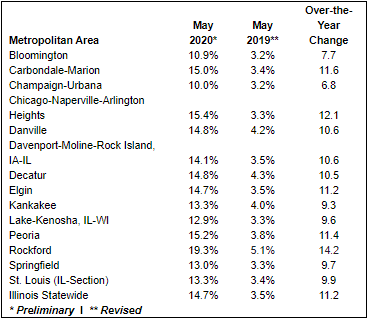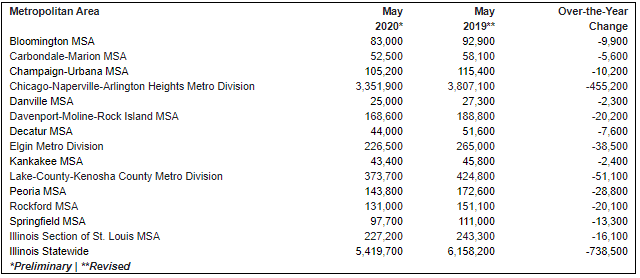SPRINGFIELD, ILLINOIS (June 25, 2020) — The number of nonfarm jobs decreased over-the-year in May in all fourteen Illinois metropolitan areas, with six metro areas at record low payrolls, according to preliminary data released today by the US Bureau of Labor Statistics (BLS) and the Illinois Department of Employment Security (IDES). Data also shows that the unemployment rate increased over-the-year in all metro areas to record highs for the month of May. The official, BLS-approved sub-state unemployment rate and nonfarm jobs series begins in 1990. Data reported prior to 1990 are not directly comparable due to updates in methodology.
“Illinois’ transition into Phase 4 of the Reopen Illinois Plan is another positive step toward the recovery of our state and local economies,” said Deputy Governor Dan Hynes. “We will continue to closely monitor the impact of the COVID-19 pandemic and make necessary adjustments to ensure the health and safety of our citizens while continuing to provide families and small businesses the resources they need for recovery.” Data shows the number of nonfarm jobs decreased in all fourteen Illinois metropolitan areas. Total nonfarm jobs were down in Peoria (-16.7%, -28,800), Decatur (-14.7%, -7,600) and Elgin (-14.5%, -38,500). Jobs were down -12.0% (-455,200) in Chicago-Naperville-Arlington Heights. Job losses occurred across all industries and there were no industry sectors that recorded job growth in a majority of metro areas.
Not-seasonally-adjusted data compares May 2020 with May 2019. The not-seasonally-adjusted Illinois rate was 14.7 percent in May 2020, a record high for the month of May, dating back to 1976. Nationally, the not-seasonally-adjusted unemployment rate was 13.0 percent in May 2020, also a record high, dating back to 1948. The unemployment rate identifies those individuals who are out of work and seeking employment.
Not Seasonally Adjusted Unemployment Rates

Total Nonfarm Jobs (Not Seasonally Adjusted) — May 2020

Not Seasonally Adjusted Unemployment Rates (percent) for Local Counties and Areas

Davenport-Moline-Rock Island IL-IA MSA
The not-seasonally-adjusted unemployment rate increased to 14.1 percent in May 2020 from 3.5 percent in May 2019. The May 2020 unemployment rate is the highest May unemployment rate on record.
Total nonfarm employment decreased -20,200 compared to May 2019.
Leisure-Hospitality (-7,300), Professional-Business Services (-3,800), Government (-2,900), Manufacturing (-1,700), and Retail Trade (-1,400) sectors recorded the largest employment declines compared to one year ago. The Construction (+200) sector reported payroll gains.
The unemployment rate identifies those who are out of work and seeking employment. A person who exhausts benefits, or is ineligible, still will be reflected in the unemployment rate if they actively seek work.
Note: Monthly 2019 unemployment rates and total nonfarm jobs for Illinois metro areas were revised in February and March 2020, as required by the US BLS. Comments and tables distributed for prior metro area news releases should be discarded as any records or historical analysis previously cited may no longer be valid. The official monthly unemployment rate series for metro areas, counties and most cities begins in 1990. The official monthly nonfarm jobs series for metro areas begins in 1990 and for non-metropolitan counties it begins in 1999.










